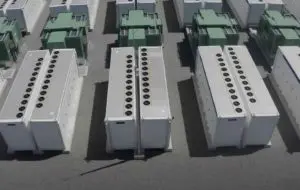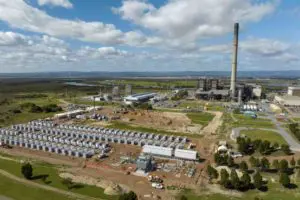As the Australian electricity system transitions away from fossil fuel generation a “firming” technology is needed to make variable energy sources, such as wind and solar, “dispatchable”.
The gas lobby would have you think that needs to be ‘gas peakers’. Yes, they may have a role. As will pumped hydro. But batteries can do this. Now.
Electricity storage in the form of batteries is an established technology, it is already cost-competitive with gas, is rapidly deployable (try building a gas plant in twelve months!), and it is clean.
Batteries can do this, but the industry needs help from governments and authorities.
That doesn’t mean hard earned tax-payer money. Yet again, it means supporting the market to do the job by getting rid of roadblocks. The most important of which is the uncertainties about income streams that are a major roadblock towards getting the support from investors and banks which is needed.
To meet AEMO’s 2024 Integrated System Plan (ISP) Step Change scenario, Australia needs a total of 19 GW of storage (both grid-scale and ‘behind-the-meter’) by 2030 and 57 GW by 2050.
Of this, AEMO believe we will need 10.4 GW of medium and shallow utility-scale batteries by 2030. Currently we only have 1.4 GW battery capacity and a further 1.6 GW of pumped hydro. There’s a lot to do.
While understanding the critical role that batteries can play in the clean energy transition is well-developed, the financing arrangements are less clear and the services to support energy storage are not being developed. Experience in investing in large-scale batteries is limited in Australia with a lack of clarity on the revenue streams and the path to secure income.
The business models for batteries (with stacked and multiple income streams) are complex and lithium-ion batteries have shorter lifetime than fossil fuel or renewable generation projects.
This means that key investors lack confidence in battery projects which leads to them pricing in a risk premium that results in either a high financing cost that erodes projected revenue, or a failure to secure the financial close needed to progress a project.
As such, over 50% of the currently connected batteries, in the National Electricity Market (NEM) have required policy support to progress such as relying on state and federal government schemes to secure financing. This is particularly true for batteries with a duration of greater than 2 hours.
Nexa Advisory, commissioned by the Clean Energy Investor Group (CEIG) to undertake research to define the challenges and propose policy solutions that are practical and support the deployment of significant energy storage projects required for a smooth transition.
Key challenges to ‘financeability’
A consistent message from energy storage developers was that the lack of clarity about when coal power stations will close and exit the system is deterring investors in storage because revenue streams are uncertain and difficult to model.
Revenue streams are more certain for short-duration batteries of 1-2 hours. However, sources of revenue are limited to energy arbitrage and provision of FCAS. Both of these revenue streams are volatile.
However, Batteries of greater than 2-3 hours duration are not supported by the current ancillary service market. FCAS favours speed of response over energy availability.
There is limited competition in the Power Purchasing Agreements (PPA) market which is dominated by incumbents, restricting the opportunity for revenue and financing opportunities.
Many financial institutions and lenders do not consider PPA off-take agreements unless the counterparty has a very high credit rating, creating a dependence on incumbent players.
While storage typically benefits from volatility in the energy market, new services markets and contracts for existing and new markets are missing.
Contracts offered by AEMO for services are short, of the order of 2-3 years, which may be appropriate for assets that have paid down their original investment but is not supportive of new entrants or new technologies, such as batteries.
Research and development in the energy sector in Australia is significantly underfunded, representing 0.019% of GDP. This is below the global average, and declining from a high in 2013.
Additionally, over 34% (2021) of R&D funding is directed at fossil fuel activities, , rather than at the technologies we need for a clean power system[1]. Only 5% of funding is going to storage technologies.
Awareness in the financial sector of the revenue opportunities, and understanding of the technology, is low. This means that developers have to educate financiers and/or take on more risk themselves in order to progress a project.
“A call to action” to federal and state governments
Coal-fired power station closure certainty is pivotal
Certainty necessitates a balanced approach, combining both incentives and regulatory measures, to ensure a smooth and effective transition.
A fixed timetable for coal-fired power stations to cease operation would provide certainty for the owners and operators, AEMO and developers of new generation and storage projects.
Develop markets and contracts to facilitate investment
Energy ministers must direct the Australian Energy Market Commission (AEMC) and AEMO to reassess rule changes which are creating obstacles to batteries and energy storage, and undertake a review of potential new market services that would provide additional revenue streams for the services for batteries such as inertia and system strength.
Invest in Long-Duration Energy Storage (LDES)
Federal and state energy ministers should prioritise and fund research and development into LDES technologies in Australia, scalable long duration technologies, such as flow batteries and liquid air energy storage.
Ensure transparency in Capacity Investment Scheme (CIS) mechanism development
The development of the CIS mechanism must be conducted transparently with a feedback loop for lessons and program improvements.
Energy ministers to ensure fit-for-purpose approvals for storage
Energy ministers should prioritise all approval processes related to storage projects. This includes stream lining connections, environmental assessments and planning approvals.
Federal and state government and industry should collaborate to support education and outreach
Comprehensive education and outreach programs are needs as a joint initiative between industry and government to raise awareness and understanding of storage across the finance sector.
Federal government should ensure that Your Future, Your Super (YFYS) benchmarks facilitate investment in LDES
The framework and benchmarks for YFYS should be designed to facilitate and encourage superannuation funds to invest in LDES.
Simon Corbell is CEO of the Clean Energy Investors Group. Stephanie Bashir in principal of Nexa Advisory.










